External links
- "Country Ham vs. City Ham". Real Simple. Retrieved 2017-09-19.
- Farm Flavor (2010-04-15). "5 Ham Questions and Answers". Farm Flavor. Retrieved 2017-09-19.
City ham is a term used in some parts of the United States for any lightly cured and/or smoked ham which must be refrigerated to preserve it. It is generally "wet cured", that is injected with or soaked in a brine solution containing high concentrations of salts (including sodium chloride, sodium nitrate, and sodium nitrite). This is distinguished from country hams which are dry cured by being packed in crystalline curing salts and stored at room temperature. In parts of the U.S. where country ham is not consumed, city hams are often the only available hams and are just called ham.
City hams may be sold pre-cooked and "ready-to-eat", or simply cured and smoked, which must then be cooked before consuming. Many types of city ham are sliced as cold cuts in delicatessens and served as part of a ham sandwich.

Ham is pork from a leg cut that has been preserved by wet or dry curing, with or without smoking. As a processed meat, the term "ham" includes both whole cuts of meat and ones that have been mechanically formed.

Smoking is the process of flavoring, browning, cooking, or preserving food by exposing it to smoke from burning or smoldering material, most often wood. Meat, fish, and lapsang souchong tea are often smoked.
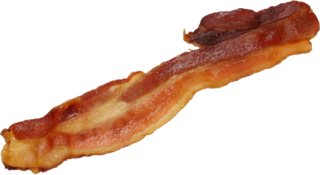
Bacon is a type of salt-cured pork made from various cuts, typically the belly or less fatty parts of the back. It is eaten as a side dish, used as a central ingredient (e.g., the bacon, lettuce, and tomato sandwich, or as a flavouring or accent.

A sausage is a type of meat product usually made from ground meat, often pork, beef, or poultry, along with salt, spices and other flavourings. Other ingredients such as grains or breadcrumbs may be included as fillers or extenders.

Smoked salmon is a preparation of salmon, typically a fillet that has been cured and hot or cold smoked.

Prosciutto crudo, in English often shortened to prosciutto is Italian uncooked, unsmoked, and dry-cured ham. Prosciutto crudo is usually served thinly sliced.
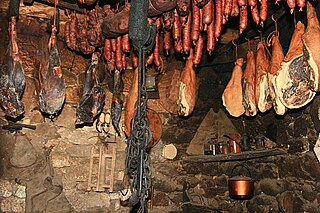
Smoked meat is the result of a method of preparing red meat, white meat, and seafood which originated in the Paleolithic Era. Smoking adds flavor, improves the appearance of meat through the Maillard reaction, and when combined with curing it preserves the meat. When meat is cured then cold-smoked, the smoke adds phenols and other chemicals that have an antimicrobial effect on the meat. Hot smoking has less impact on preservation and is primarily used for taste and to slow-cook the meat. Interest in barbecue and smoking is on the rise worldwide.

Jamón is a kind of dry-cured ham produced in Spain. It is one of the most globally recognized food items of Spanish cuisine. It is also regularly a component of tapas.

The origins of meat preservation are lost to the ages but probably began when humans began to realize the preservative value of salt. Sausage making originally developed as a means to preserve and transport meat. Primitive societies learned that dried berries and spices could be added to dried meat. The procedure of stuffing meat into casings remains basically the same today, but sausage recipes have been greatly refined and sausage making has become a highly respected culinary art.

Charcuterie is a French term for a branch of cooking devoted to prepared meat products, such as bacon, ham, sausage, terrines, galantines, ballotines, pâtés, and confit, primarily from pork.
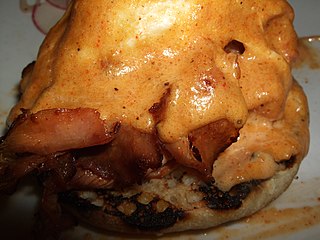
Tasso ham is a smoked, spiced, and cured meat, a specialty of south Louisiana cuisine. In this case "ham" is a misnomer since tasso is not made from the hind leg of a hog, but rather the hog's shoulder. This cut is typically fatty, and because the muscle is constantly used by the animal, has a great deal of flavor. The shoulder, which will weigh 7 to 8 pounds, is sliced across the grain into pieces about 3 in thick. These are dredged in a salt cure, which usually includes sodium nitrite and sugar. The meat is left to cure briefly, only three or four hours, then rinsed, rubbed with a spice mixture containing cayenne pepper and garlic, and hot-smoked until cooked through.

Black Forest ham is a variety of dry-cured smoked ham produced in the Black Forest region of Germany.
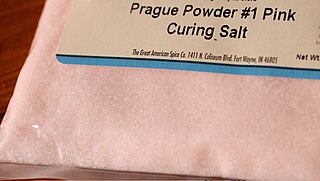
Curing salt is used in meat processing to generate a pinkish shade and to extend shelf life. It is both a color agent and a means to facilitate food preservation as it prevents or slows spoilage by bacteria or fungus. Curing salts are generally a mixture of sodium chloride and sodium nitrite, and are used for pickling meats as part of the process to make sausage or cured meat such as ham, bacon, pastrami, corned beef, etc. Though it has been suggested that the reason for using nitrite-curing salt is to prevent botulism, a 2018 study by the British Meat Producers Association determined that legally permitted levels of nitrite have no effect on the growth of the Clostridium botulinum bacteria that causes botulism, in line with the UK’s Advisory Committee on the Microbiological Safety of Food opinion that nitrites are not required to prevent C. botulinum growth and extend shelf life..
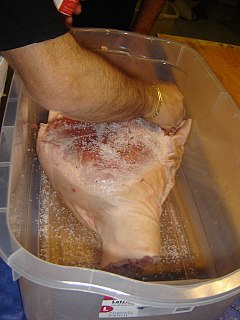
Curing is any of various food preservation and flavoring processes of foods such as meat, fish and vegetables, by the addition of salt, with the aim of drawing moisture out of the food by the process of osmosis. Because curing increases the solute concentration in the food and hence decreases its water potential, the food becomes inhospitable for the microbe growth that causes food spoilage. Curing can be traced back to antiquity, and was the primary method of preserving meat and fish until the late-19th century. Dehydration was the earliest form of food curing. Many curing processes also involve smoking, spicing, cooking, or the addition of combinations of sugar, nitrate, and nitrite.

Cured fish is fish which has been cured by subjecting it to fermentation, pickling, smoking, or some combination of these before it is eaten. These food preservation processes can include adding salt, nitrates, nitrite or sugar, can involve smoking and flavoring the fish, and may include cooking it. The earliest form of curing fish was dehydration. Other methods, such as smoking fish or salt-curing also go back for thousands of years. The term "cure" is derived from the Latin curare, meaning to take care of. It was first recorded in reference to fish in 1743.

The cuts of pork are the different parts of the pig which are consumed as food by humans. The terminology and extent of each cut varies from country to country. There are between four and six primal cuts, which are the large parts in which the pig is first cut: the shoulder, loin, belly and leg. These are often sold wholesale, as are other parts of the pig with less meat, such as the head, feet and tail. Retail cuts are the specific cuts which are used to obtain different kinds of meat, such as tenderloin and ham. There at least 25 Iberian pork cuts, including jamón.

Cakalang fufu is a cured and smoked skipjack tuna clipped on a bamboo frame, a Minahasan delicacy of North Sulawesi, Indonesia.
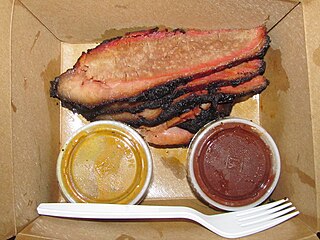
A smoke ring is a region of pink colored meat in the outermost 8-10 millimeters of smoked meats. It is usually seen on smoked chicken, pork, and beef. There is some debate as to whether or not the presence of the smoke ring is actually an indicator of quality of the finished barbecue product but it is widely considered to be a desirable characteristic of barbecue.